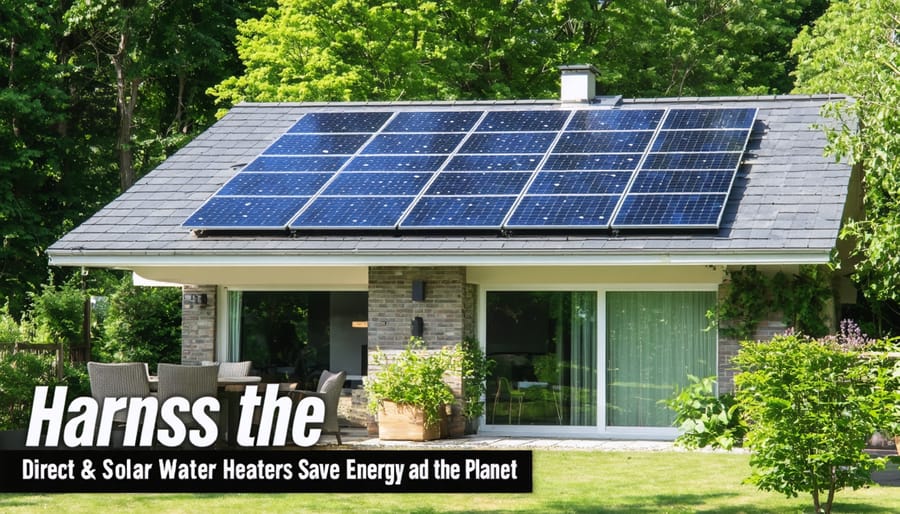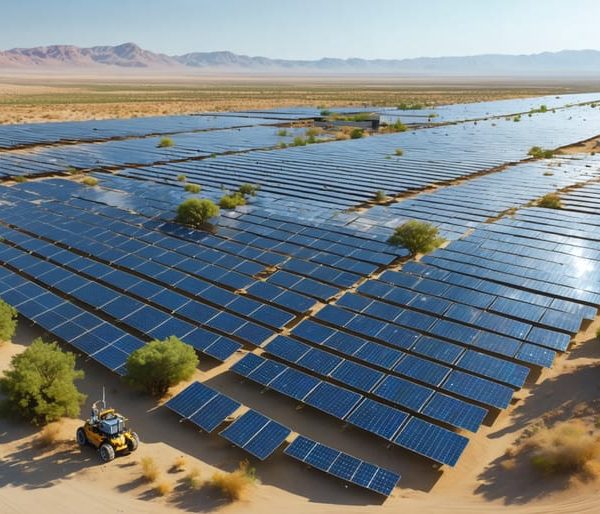Direct Solar Water Heaters: Cut Your Energy Bills While Saving the Planet
Transform your home’s energy landscape with a direct solar water heater – the most efficient way to heat water with solar energy. This innovative system captures sunlight directly in roof-mounted collectors, heating your water without electricity while slashing utility bills by up to 80%. Unlike traditional water heaters, direct solar systems integrate seamlessly with your existing plumbing, providing reliable hot water year-round while significantly reducing your carbon footprint.
For homeowners seeking sustainable solutions, direct solar water heaters represent the perfect blend of environmental responsibility and practical efficiency. These systems require minimal maintenance, offer an impressive 15-20 year lifespan, and can even increase your property value. Whether you’re building a new home or upgrading your current water heating system, this technology offers a smart investment that pays dividends both environmentally and financially.
How Direct Solar Water Heaters Transform Sunlight into Hot Water
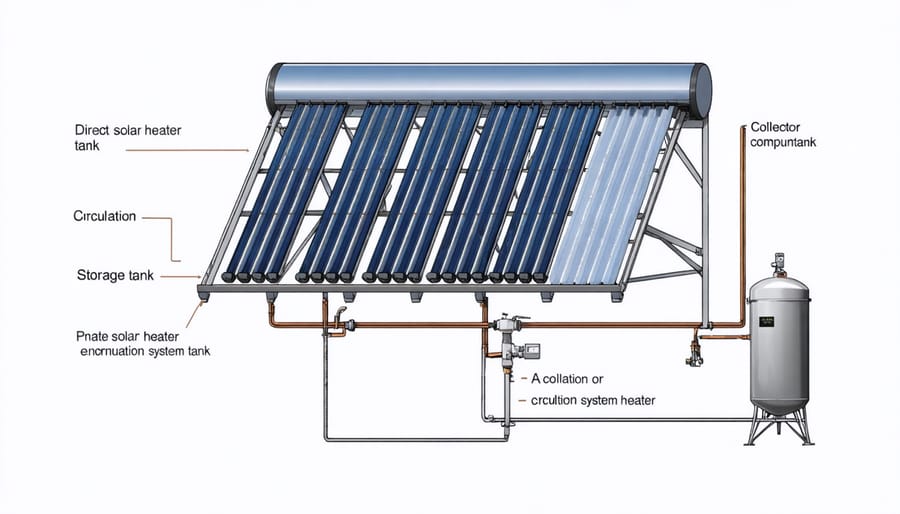
The Solar Collector: Your Personal Sun Catcher
At the heart of thermal solar water heating systems lies the solar collector, a remarkable device that transforms sunlight into usable heat energy. Think of it as your personal sun catcher, working tirelessly to harness solar energy for your hot water needs.
Solar collectors come in two main varieties: flat-plate collectors and evacuated tube collectors. Flat-plate collectors feature a dark, flat surface that absorbs sunlight, covered by a glass or plastic sheet that helps trap heat. Beneath this surface runs a network of pipes filled with water or heat-transfer fluid. As sunlight hits the dark surface, it heats the fluid inside these pipes.
Evacuated tube collectors take a more sophisticated approach, using glass tubes with a vacuum inside. This vacuum acts like a thermos, minimizing heat loss and making these collectors particularly efficient, even in cooler climates. Each tube contains a copper pipe filled with heat-transfer fluid, which carries the collected heat to your water tank.
Both types are designed to maximize solar absorption while minimizing heat loss, ensuring you get the most out of the sun’s free energy.
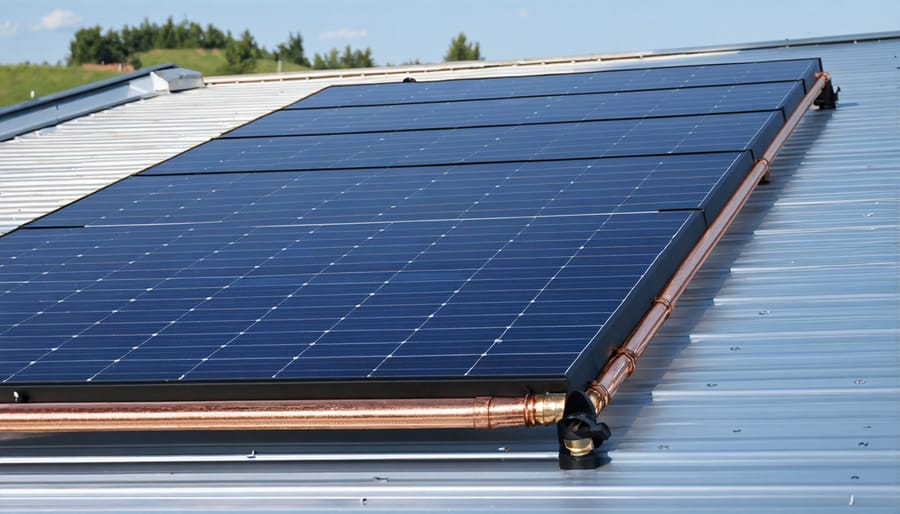
Storage Tank and Circulation System
The storage tank is the heart of a direct solar water heater, working together with a well-designed circulation system to provide reliable hot water throughout the day. Most residential systems use an insulated tank ranging from 50 to 120 gallons, strategically positioned above the solar collectors to enable natural water flow.
The circulation system operates through either passive or active methods. In passive systems, hot water naturally rises from the collectors to the tank through thermosiphon flow – a simple yet effective process that requires no pumps or electricity. This makes passive systems particularly reliable and cost-effective for sunny climates.
Active systems use small, efficient pumps and controllers to move water between the collectors and storage tank. While these systems consume minimal electricity, they offer better control over water circulation and are ideal for colder regions where freeze protection is necessary.
Both tank and circulation components are insulated to maintain water temperature overnight and during cloudy periods. Modern tanks feature special coatings and materials that prevent corrosion and mineral buildup, extending system life and maintaining efficiency. A backup heating element ensures hot water availability during extended periods of low sunlight.
Benefits That Make Direct Solar Water Heaters Worth It
Energy Bill Savings You Can Expect
Installing a direct solar water heater can lead to significant savings on your energy bills, making the cost-effectiveness of solar water heating immediately apparent. Typically, homeowners see a 50-80% reduction in their water heating costs, which can translate to annual savings of $200-$600 for an average family of four.
Let’s break down these savings:
– Monthly water heating bill before solar: $40-60
– Monthly water heating bill after solar: $8-30
– Potential yearly savings: Up to $600
– Return on investment period: 3-7 years
The exact savings depend on several factors:
– Your local climate and sun exposure
– Current energy prices in your area
– Hot water usage patterns
– System size and efficiency
– Existing water heater type
Keep in mind that energy prices typically rise over time, which means your savings will likely increase year after year. Many homeowners report that their systems paid for themselves faster than expected due to rising utility costs and improved energy efficiency habits.
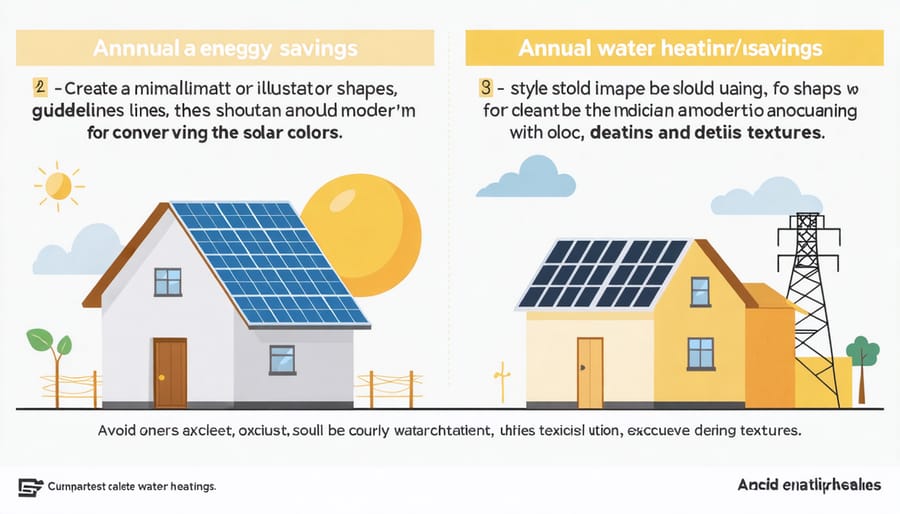
Environmental Impact and Carbon Footprint Reduction
Direct solar water heaters make a significant positive impact on our environment by reducing greenhouse gas emissions and decreasing dependence on fossil fuels. A typical household system can prevent approximately 2.5 tons of carbon dioxide emissions annually – equivalent to taking a car off the road for six months.
These systems operate without electricity or gas, harnessing pure solar energy to heat water, which means zero operational carbon footprint. When you switch from a conventional electric water heater to a direct solar system, you’re not just saving money; you’re actively contributing to environmental conservation.
The environmental benefits extend beyond carbon reduction. Direct solar water heaters help preserve natural resources by minimizing the need for electricity generation from coal or natural gas plants. They also reduce water pollution associated with traditional power generation methods.
The systems themselves are built to last 15-20 years and are largely recyclable at the end of their life cycle. Many components, including copper piping and aluminum frames, can be repurposed or recycled, further reducing their environmental impact. By choosing a direct solar water heater, you’re making a long-term investment in both your home and our planet’s future.
Installation and Maintenance Made Simple
Choosing the Perfect Spot for Your System
The success of your direct solar water heater largely depends on choosing the right location for installation. The ideal spot should receive maximum sunlight throughout the day, typically facing south in the Northern Hemisphere. Look for an area free from shadows cast by trees, buildings, or other structures, especially during peak sun hours between 9 AM and 3 PM.
Your roof is often the perfect location, but ensure it’s structurally sound and can support the system’s weight. The slope should ideally be between 30-45 degrees for optimal sun exposure, though this can vary based on your geographical location. If roof installation isn’t feasible, consider ground-mounted options or wall installations on south-facing walls.
Weather conditions also play a crucial role. The system should be protected from strong winds while remaining accessible for maintenance. In colder climates, choose a spot that minimizes exposure to freezing temperatures. Keep in mind the distance between the solar collector and your water tank – shorter pipe runs reduce heat loss and installation costs.
Before finalizing the location, check local building codes and HOA regulations to ensure compliance with all requirements.
Essential Maintenance Tips
To keep your direct solar water heater running efficiently, follow these essential maintenance steps throughout the year. Clean the collector glass every three months using mild soap and water to remove dust, leaves, and bird droppings that can reduce efficiency. During this cleaning, check for any cracks or damage to the glass surface.
Inspect the insulation around pipes and storage tanks twice a year to ensure it remains intact and effective. Replace any damaged insulation promptly to prevent heat loss. Check all connections and joints for leaks or corrosion every six months, tightening fittings as needed.
Test the pressure relief valve annually by lifting the lever and letting it snap back. If water doesn’t flow freely, replace the valve immediately. Flush your storage tank once a year to remove sediment buildup that can reduce heating efficiency and system lifespan.
In colder regions, check antifreeze levels before winter and top up if necessary. Have a professional inspection done annually to catch potential issues early and ensure optimal performance. Remember to keep vegetation trimmed around the collectors to prevent shading and maintain maximum sun exposure.
Common Issues and Quick Fixes
If your solar water heater isn’t performing optimally, check these common issues first. Low water temperature often results from collector panel shading or dirt buildup – a simple cleaning can restore efficiency. Leaking connections typically need tightening or replacement of worn-out seals. If you notice reduced water flow, inspect the system for air locks and bleed the system if necessary.
During winter, freezing can damage collectors and pipes. Ensure your drain-back system is working properly or maintain antifreeze levels in closed-loop systems. Strange noises usually indicate trapped air or pump issues – try bleeding the system or calling a professional if the noise persists.
For storage tank problems, check the anode rod annually and replace it if corroded. Regular maintenance and prompt attention to these issues will keep your system running efficiently for years.
Real Home Success Stories
Meet Sarah Thompson from Arizona, who installed a direct solar water heater three years ago. “Our monthly energy bills dropped by 70% during summer months,” she shares. “The initial investment paid for itself within two years, and now we’re enjoying essentially free hot water while helping the environment.”
The Martinez family in New Mexico transformed their bed & breakfast’s water heating system with impressive results. “We installed a direct solar water heater to serve our six-room property,” explains Carlos Martinez. “Our guests love knowing they’re staying at an eco-friendly establishment, and we’ve saved over $2,400 annually on water heating costs.”
John Chen, a retired engineer from California, monitors his system’s performance meticulously. “Even on cloudy days, we get enough hot water for our family of four. The maintenance is minimal – just annual checkups and occasional glass cleaning. It’s been the most reliable home improvement we’ve made.”
Commercial success stories are equally compelling. The Summit View Community Center in Colorado replaced their conventional water heaters with a direct solar system. “Our swimming pool and shower facilities now use 80% less electricity for water heating,” reports facility manager Lisa Brooks. “The system has been operating flawlessly for five years, proving that solar water heating works at scale.”
Direct solar water heaters represent a powerful step toward a more sustainable future, offering an elegant solution that harnesses the sun’s energy to meet our daily hot water needs. By choosing these systems, homeowners can significantly reduce their carbon footprint while enjoying substantial savings on their energy bills. The technology’s simplicity, combined with its effectiveness, makes it an attractive option for those looking to embrace eco-friendly living.
Remember, every sustainable choice we make today shapes our tomorrow. Whether you’re motivated by environmental concerns, cost savings, or energy independence, installing a direct solar water heater is a meaningful investment in our planet’s future. The benefits extend beyond individual households to contribute to broader community sustainability goals.
Take the first step toward sustainable living by considering a direct solar water heating system for your home. With proper maintenance and installation, these systems can provide reliable hot water for decades while helping protect our environment. Join the growing community of homeowners who are making a difference through smart, sustainable energy choices. Your action today can inspire others and create a ripple effect of positive environmental change.

